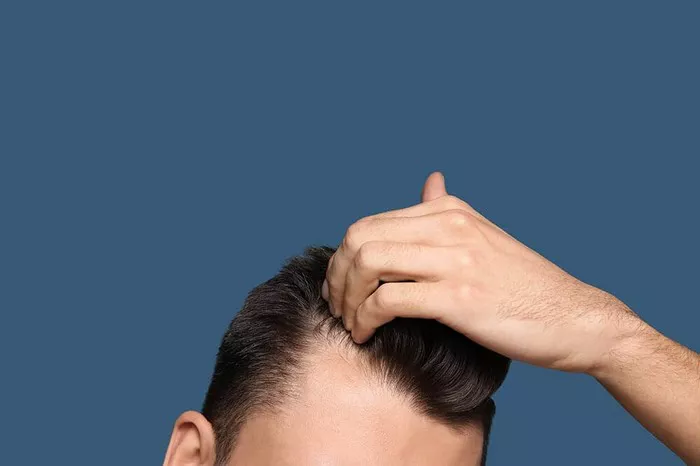For many, the anxiety of hair loss may strike early in life, with some men experiencing it as early as their late teens or early 20s. However, the most apparent signs of male-pattern baldness often emerge in one’s 30s, with a staggering 50% of men grappling with significantly thinning hair by age 50.
Thankfully, the realm of science has been diligently developing and refining treatments, offering hope to those facing hair loss. The key lies in identifying the type of hair loss and employing targeted solutions to address the specific condition.
Identifying the Hair Loss Types
Hair Loss Type 1: Telogen Effluvium
This condition, influenced by a range of factors, including illness, medications, hormonal shifts, and stress, accelerates the hair’s shedding phase, leading to overall thinning across the scalp. Major life events, such as surgery and significant illness, can trigger this condition, which notably saw an increase during the pandemic.
Hair Loss Type 2: Androgenetic Alopecia
Known as male-pattern hair loss, this condition manifests as a receding hairline and thinning at the crown. It’s the most prevalent form of hair loss and is genetically inherited.
Hair Loss Type 3: Alopecia Areata
This issue, characterized by circular hair loss on the scalp, results from the immune system’s attack on hair follicles. It can affect any hair-bearing region of the body, with beards and eyebrows being commonly affected.
Hair Loss Type 4: Anagen Effluvium
This type of hair loss is swift and can be induced by medications, chemotherapy, and other physiological stressors.
Effective Solutions for Hair Loss
Hair Loss Solution #1: Turn on the Lights
Target: Alopecia Areata
A promising treatment for hair loss involves utilizing specific wavelengths of red light. Dermatologist Robert Finney, M.D., explains that clinical trials have validated the effectiveness of red light therapy in countering signs of genetic hair loss. This therapy targets bulge cells at the base of hair follicles, enhancing blood flow, reducing inflammation, and promoting healthy hair growth.
For optimal results, Dr. Finney recommends devices with red light emitting wavelengths between 620 and 678 nanometers. In cases where users have thick hair and are using red light as a preventive measure, choosing a device that allows parting the hair is preferable. Notably, consistent use of these devices is essential, and combining them with other treatments enhances their efficacy.
Hair Loss Solution #2: Double Up
Target: Androgenetic Alopecia
A clinically proven approach to treating male-pattern hair loss involves the combination of minoxidil and finasteride. Dr. Evan Rieder, M.D., highlights the importance of these medications, as minoxidil acts as a vasodilator, increasing blood flow to the hair follicles, while finasteride regulates hormones, preventing the conversion of testosterone into DHT, which is linked to hair-follicle miniaturization. These two treatments complement each other for effective results.
Typically, minoxidil is applied topically, while finasteride is taken orally. Recent combinations, including oral finasteride and oral minoxidil, have shown effectiveness. Additionally, there is a surge in sprays and serums containing these ingredients. Topical preparations of finasteride offer a lower risk of side effects, such as depression and erectile dysfunction, according to Dr. Rieder. It’s important to note that while topical finasteride shows promise, it is not yet FDA approved. Thus, the decision to switch should be made considering the mitigation of potential side effects for those already taking oral finasteride without issues.
Hair Loss Solution #3: The New Transplant
Targets: Androgenetic Alopecia, Alopecia Areata, Anagen Effluvium
Follicular unit extraction (FUE) has emerged as a cutting-edge standard in hair transplants. During the procedure, individual hair follicles are extracted from the back or sides of the head and transplanted to areas with visible hair loss, such as the hairline and crown.
Distinguished from traditional hair transplants, FUE leaves no visible linear scar, as hair grafts are taken with small punches. Patients can maintain short hair or even shave their heads without revealing scars. The procedure lasts six to eight hours, with a one- to two-week recovery period. Swelling can persist for up to a week post-surgery.
FUE is a viable option for individuals with thick hair on the posterior scalp and non-rapidly progressive hair loss. On the flip side, unstable hair loss, a limited donor site, unrealistic expectations, or complex medical issues may make one an unsuitable candidate. Costs range from $12,000 to $30,000 based on the number and quality of grafts.
Hair Loss Solution #4: Reduce Stress
Target: Telogen Effluvium
For Telogen Effluvium, the solution is simple: manage stress. Recognize that this condition is typically time-limited and should subside within weeks to months without lasting consequences. If it persists, consulting a healthcare professional is advisable.


